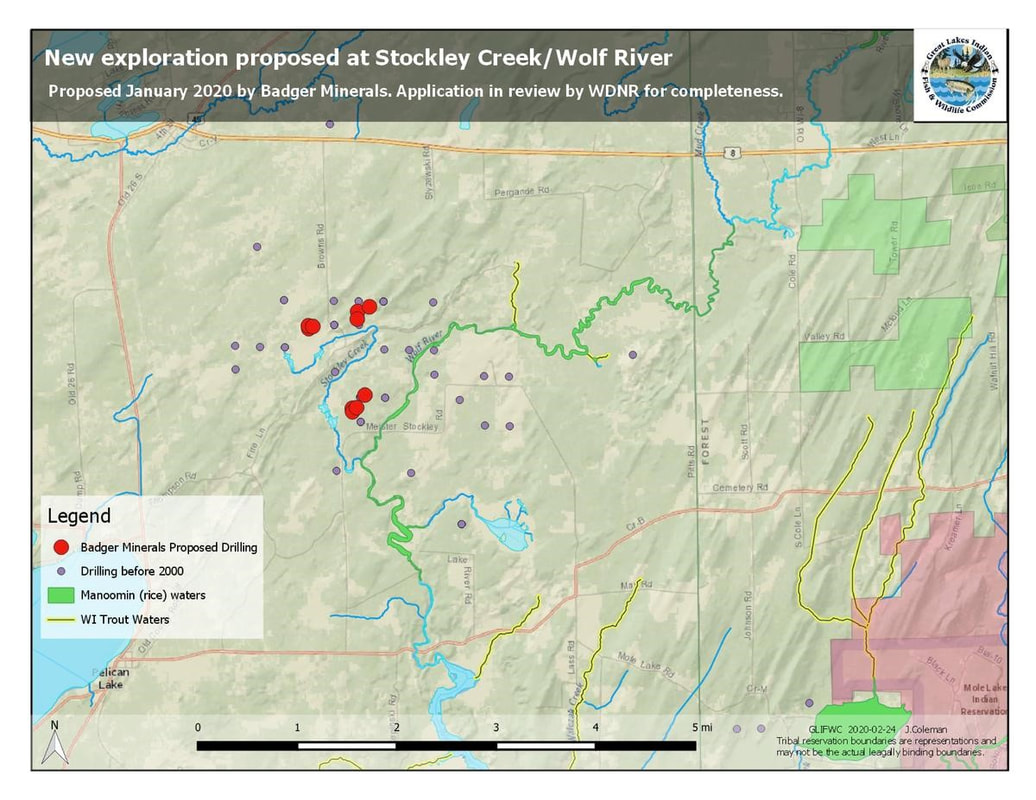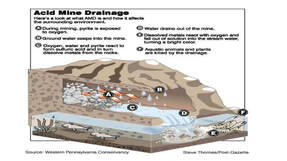Recent/Potential Mining ProjectsLocation: Shoepke Township, Oneida County
The Shoepke site was previously explored in the late 1970’s by Noranda, Inc. and is located in the town of Shoepke in southeast Oneida County. Badger Minerals, LLC (a subsidiary of Can-American Minerals, Inc. of Thunder Bay, Ontario, Canada) has planned exploration activities for February and March, 2020 to evaluate the mineral potential of the area and was issued a metallic mineral exploration license on February 11, 2020. |
The three planned drilling sites are located on private parcels owned by Badger Minerals and Heartwood Forestland Group. Exploration drilling will include up to 10 bore holes totaling a maximum of 4,000 linear feet of borehole including rock core samples. For the most up-to-date DNR Information visit: https://dnr.wi.gov/topic/Mines/Projects.html and click on the Schoepke Tab.
Here is a recent press article from WXPR:
https://www.wxpr.org/post/mining-related-drilling-near-wolf-river-would-be-first-wisconsin-years#stream/0
Here is a recent press article from WXPR:
https://www.wxpr.org/post/mining-related-drilling-near-wolf-river-would-be-first-wisconsin-years#stream/0
The views expressed by the media in the above articles are for informational purposes and do not
necessarily reflect the views of the Oneida County Land and Water Conservation Department.
necessarily reflect the views of the Oneida County Land and Water Conservation Department.
The Latest from Oneida County
Check back soon for new information from Oneida County.
. . . . . . . . . .
State & County Policy that Guides Us
In August of 2012, the Oneida County Board established a policy that states it would not pursue leasing County property for metallic mining. In response to 2017 Act 134, Oneida County re-wrote its metallic mining ordinance. The County Board ran an advisory referendum during the November 6, 2018 general election asking the electorate whether metallic mining on County owned lands in the Town of Lynne should be allowed. The electorate responded by a nearly 2-1 margin that metallic mining should not be considered. With regard to metallic mining in Oneida County, it is the intent of the LWCD and the Conservation Committee to establish and oversee goals and objectives that protect water, land, air, and quality of life for Oneida County to the fullest extent provided under law. (CUW Committee)
State of Wisconsin ACT 134
Non Metallic Mining and Metallic Mineral Exploration, Bulk Sampling and Mining
Purpose and Duties of a Mining Impact Committee - May 1, 2018
. . . . . . . . . .
Resources
Activities and processes that occur at metallic mining sites have the potential to affect the quantity and quality of groundwater surrounding the project area. At most surface or underground mines, groundwater will flow into excavated areas and must then be pumped out in order to dewater places where mining activities are intended to take place. Depending on the site's local hydrology, mining activities may affect groundwater quantity by lowering the water table elevation, which in turn may impact nearby lake levels and base flow in streams. Additionally, groundwater quality may be affected by the handling, storage, and disposal of mining wastes; the mine excavation itself; the water-table drawdown; the wastewater discharge; and the storage and handling of chemicals, reagents, and fuels at the mine site. (WDNR)
As explicitly stated in Wisconsin's mining laws and regulations, the contamination of groundwater quality must be prevented through compliance with strict performance based standards. (WDNR)
While there have been improvements to mining practices, significant environmental risks remain. Water pollution from mine waste rock (tailings) may need to be managed for decades after closure. These impacts depend on a variety of factors, such as the susceptibility to groundwater contamination, the composition of bedrock being mined, the type of technology employed; the skill, knowledge and environmental commitment of the company; and our ability to monitor and enforce compliance with environmental regulations. One of the problems is that high-grade ore has decreased, so low-grade ore is being mined. With the mining of low-grade ore comes a much greater tonnage of waste rock, and much smaller pieces that provide a higher surface area to potentially come in contact with water.
As explicitly stated in Wisconsin's mining laws and regulations, the contamination of groundwater quality must be prevented through compliance with strict performance based standards. (WDNR)
While there have been improvements to mining practices, significant environmental risks remain. Water pollution from mine waste rock (tailings) may need to be managed for decades after closure. These impacts depend on a variety of factors, such as the susceptibility to groundwater contamination, the composition of bedrock being mined, the type of technology employed; the skill, knowledge and environmental commitment of the company; and our ability to monitor and enforce compliance with environmental regulations. One of the problems is that high-grade ore has decreased, so low-grade ore is being mined. With the mining of low-grade ore comes a much greater tonnage of waste rock, and much smaller pieces that provide a higher surface area to potentially come in contact with water.
|
Types of Potential Soil and Water Contamination
1. Acid rock drainage Many waste rocks contain sulfide minerals associated with metals, such as lead, zinc, copper, silver, or cadmium. An important sulfide mineral common in waste rock is pyrite, iron sulfide. When pyrite is exposed to air and water, it undergoes a chemical reaction called “oxidation.” |
The oxidation process produces acidic conditions that can inhibit plant growth at the surface of a waste pile. If water infiltrates into pyrite-laden waste rock, the resulting oxidation can acidify the water, enabling it to dissolve metals such as copper, zinc, and silver. This production of acidic water, is commonly referred to as “acid rock drainage.” If acid rock drainage is not prevented from occurring, and if it is left uncontrolled, the resulting acidic and metal-bearing water may drain into and contaminate streams or migrate into the local groundwater, therefore inhibiting its use for drinking water or irrigation.
2. Waste rock (tailings) erosion
Waste rock (also called tailings) disposal areas are either located as close to the mine as possible or as close to the processing plant as possible to minimize haulage costs. If not properly managed, erosion of waste rock into surface waters will most likely oxidize pyrite in the rock, leading to higher concentrations of acid and leached heavy metals into the stream bed and water, because the whole surface of this waste rock is now exposed within running water. When this occurs, the metals are considered to be “bioavailable” in the environment. Bioavailable metals are easily absorbed by plants and animals that are still alive within the acidic water, causing additional detrimental effects. Seepage from waste rock can be prevented or minimized by locating tailings basins on level topography, and placing a flexible, low-permeable barrier, such as compressed clay, at the bottom of the impoundment before waste rock disposal. Many pre-1970s tailings impoundments did not have such barriers. The infiltration of surface water into tailings can be prevented by using reclamation methods that facilitate water runoff before contacting the waste rock rather than ponding on tailings piles. If not prevented or controlled, the acidic and metal-bearing waters from tailings can impact
stream habitats and groundwater.
Source: Oneida County Land and Water Resource Management Plan
Waste rock (also called tailings) disposal areas are either located as close to the mine as possible or as close to the processing plant as possible to minimize haulage costs. If not properly managed, erosion of waste rock into surface waters will most likely oxidize pyrite in the rock, leading to higher concentrations of acid and leached heavy metals into the stream bed and water, because the whole surface of this waste rock is now exposed within running water. When this occurs, the metals are considered to be “bioavailable” in the environment. Bioavailable metals are easily absorbed by plants and animals that are still alive within the acidic water, causing additional detrimental effects. Seepage from waste rock can be prevented or minimized by locating tailings basins on level topography, and placing a flexible, low-permeable barrier, such as compressed clay, at the bottom of the impoundment before waste rock disposal. Many pre-1970s tailings impoundments did not have such barriers. The infiltration of surface water into tailings can be prevented by using reclamation methods that facilitate water runoff before contacting the waste rock rather than ponding on tailings piles. If not prevented or controlled, the acidic and metal-bearing waters from tailings can impact
stream habitats and groundwater.
Source: Oneida County Land and Water Resource Management Plan
Nonferrous Metallic Mining Frequently Asked Questions (FAQs)
Wisconsin Counties Association - Nonferrous Metallic Mining Regulation Handbook
March, 2018
March, 2018
Marathon County Ordinance-FINAL-4/10/2018
. . . . . . . . . .
Historical Information
Chapter 9 Article 6 - Oneida County Zoning and Shoreland Protection Ordinance
Non-metallic Mining and Metallic Mineral Exploration, Prospecting and Mining
Non-metallic Mining and Metallic Mineral Exploration, Prospecting and Mining
Overview of Vulnerabilities in Metallic Mining Ordinance from William Scott - April 10, 2018
distributed by Brian Desmond, Oneida County Corporation Counsel
distributed by Brian Desmond, Oneida County Corporation Counsel
Ordinance Dated: May 14, 2018
For additional information check out the following media links:
|
WXPR
|
The views expressed by the media in the above articles are for informational purposes and
do not necessarily reflect the views of the Oneida County Land and Water Conservation Department.
do not necessarily reflect the views of the Oneida County Land and Water Conservation Department.


